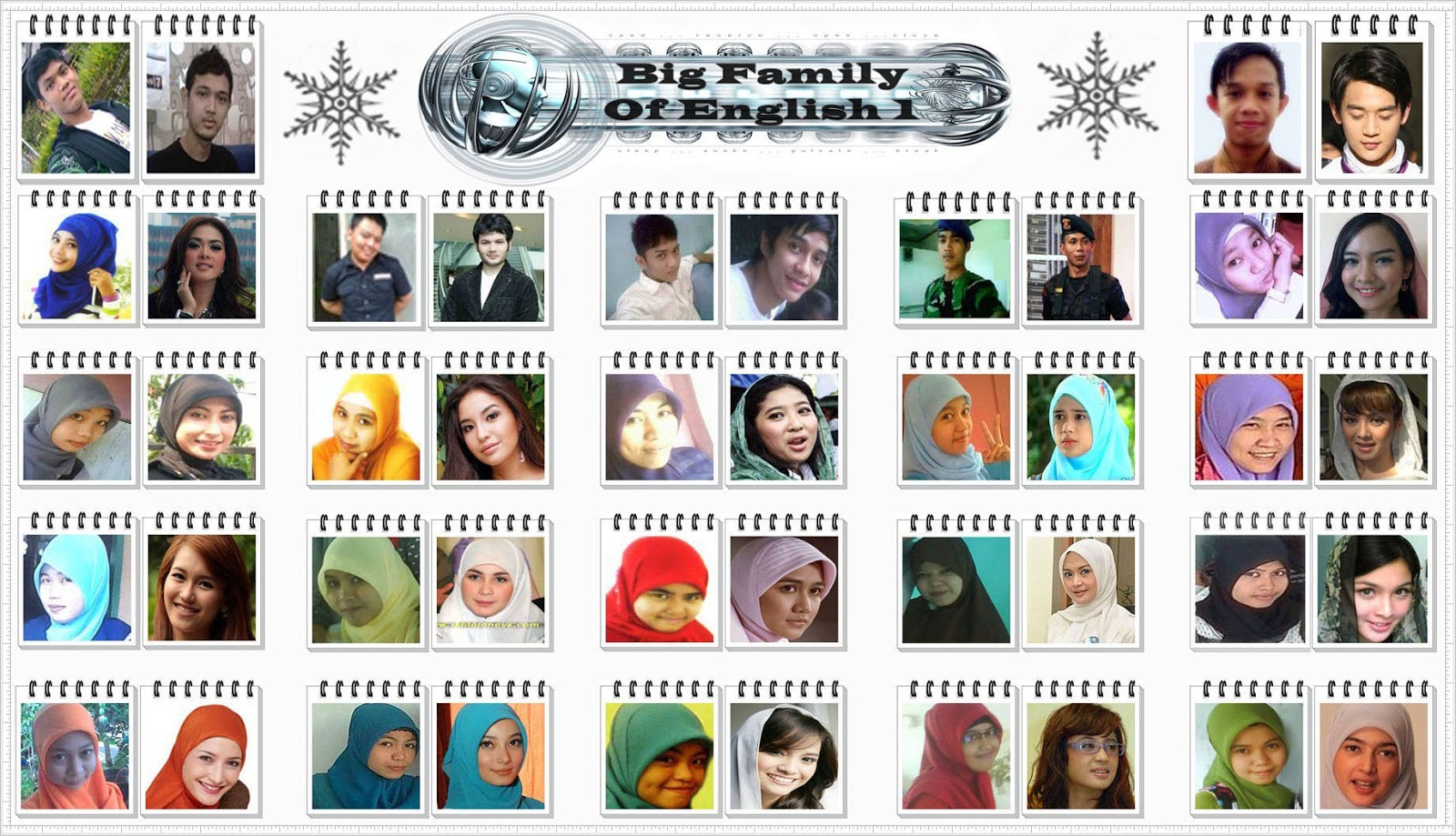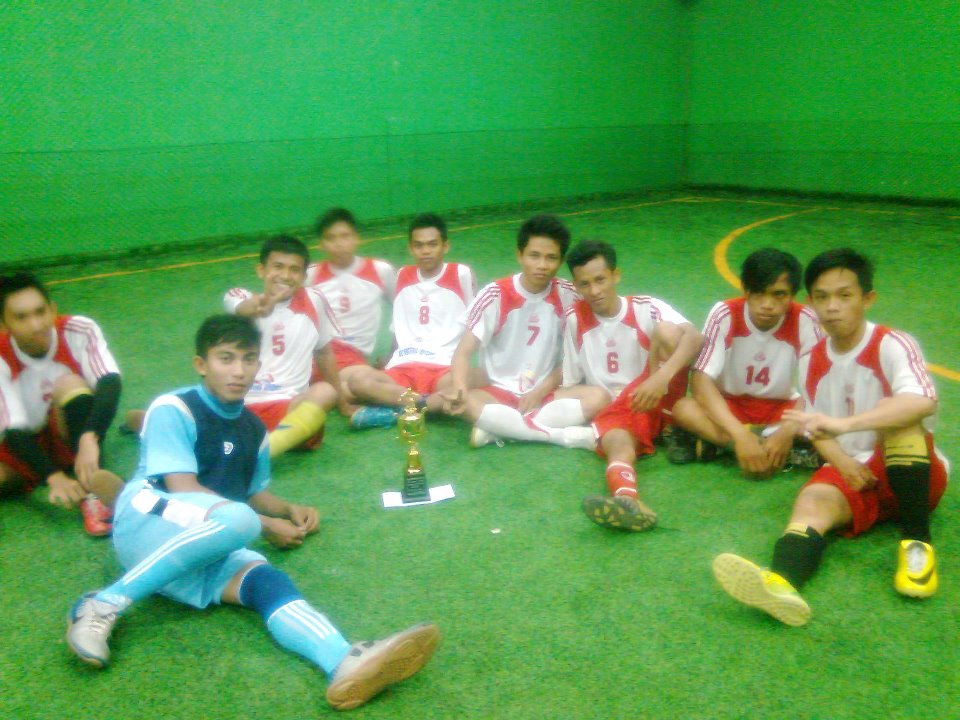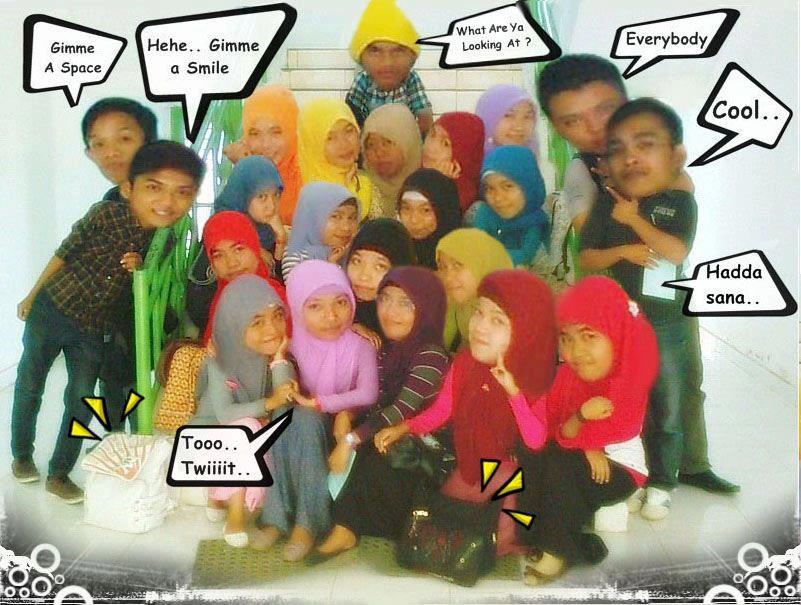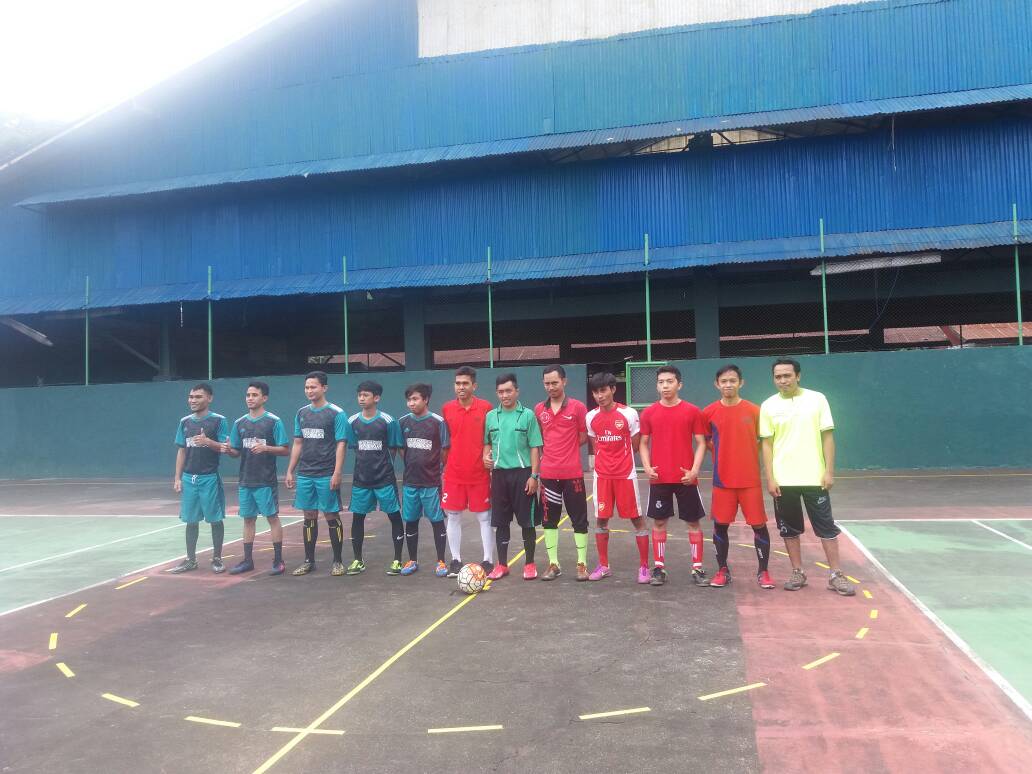INTRODUCTION
 Instructional material is one of the essential components in teaching and learning process. It assists teacher to broaden concepts as well as a tool to sharpen students’ abilities, skills and character buildings. Considering a certain material has potential to affect the quality of teaching and learning, it is worth noting that a good material mainly in general courses and particularly in English language learning has a systematic process. It should be selected and written carefully to generate an ideal model of instructional material.
Instructional material is one of the essential components in teaching and learning process. It assists teacher to broaden concepts as well as a tool to sharpen students’ abilities, skills and character buildings. Considering a certain material has potential to affect the quality of teaching and learning, it is worth noting that a good material mainly in general courses and particularly in English language learning has a systematic process. It should be selected and written carefully to generate an ideal model of instructional material. English language materials are not merely derived from one single idea or a thought, but far more beyond. The processes of selection of many resources have to be done effectively and coherently by English teacher in order to find suitable material for the students’ need. The students therefore feel more enthusiastic toward the English language learning if the material employed in a way that students can fully engage to the language learning process. Therefore according to Chomsky (1988) that 99% of teaching is making the students feel interested in the material. It is obvious that the students also play role in determining the way of language material developed.
Instructional materials have an indispensable role as they facilitate language learning (Tomlinson, 2008). As regards the use materials to foster foreign language learning, foreign language teachers are expected to employ them at the right time and in the right proportion. This paper offers a step which showing processes of selecting materials until writing materials for teacher’s own necessity based on well-established frameworks. Concerning myriad of benefits to both teachers and learners in teaching and learning English as a foreign language (EFL) context, the process of selecting materials and writing in this paper need to be included in the agendas of teachers.
While the main focus of the following paper is to describe the process of selecting materials and writing materials in the context of academic English courses, the organization of the topic especially in writing material section is also presented systematically by providing a continuous EFL exemplar case related to frameworks developed by scholars in order to provide insights into how the material fundamentally written in the EFL context.
Regarding to some statement above, finally this paper will discuss some related topics namely:
a. The roles and function of course books;
b. Materials evaluation and selection;
c. A framework for the selection of course books;
d. The process of writing materials;
DISCUSSION
Nowadays ELT materials have evolved into more complex objects. In the past the students commonly dealt with several reading texts accompanied by a set of comprehension questions and there was only a few grammar and vocabulary exercises. Today, ELT materials provides rich contents in which the students can use them for language learning which include workbooks, teacher’s guides, audio and video support and even the current trend of using technology like CALL programs to support language learning as the indications that the practitioner are working harder to effectively create and ideal classroom for language learning. In this regard, the teacher who handle the classroom must be aware that any kinds of material is also selected based upon his/her decision.
The selection of material includes; corresponding the material to the context which they are going to be used according to the needs and interest of students and teacher. It is aimed to find the best fit of them. Littlejohn (1998) in Rubdy (2007) observes that the use of a set of material need to be able to examine whether or not the methodology and content is appropriate to the students, teacher, and classroom for particular language teaching context.
1. The Roles and Function of Course books
Course book are a key component in most language program. It provides the basis for the content of the lessons, the balance of skills taught and the kinds of language practice the students take part in. In broader aspect, the course books offer the teacher and the learners a variety of professionally developed materials within tried and tested syllabus structures. It also provided flexibly which means can be adapted and supplemented according to the need of the specific classroom. There are some advantages using course book according to Bell and Gower (2011);
a. The course books accomplish a wide variety of practical needs, particularly the context of teaching English in non-English speaking environment and where the teacher lack of training to analyze the needs of particular group.
b. The course books help in providing a guide for both teachers and learners.
c. The course books offer structure and predictability which aimed to give the learners social interactions, a platform for negotiation, and exploration.
d. The course books free the teacher using more important aspects of lesson planning and to concentrate on using their creative skills.
e. The course books offer teacher who lack in training and experience with a sense of self-confidence and security
f. Most course books are designed and developed by experts in the field.
g. The course books can act as agent of change and creating innovative ideas to be structured framework in way the teacher and learners develop in harmony.
2. Materials Selection
The selection of materials inevitably includes a process of evaluation which can be taken from variety of purposes and carried out in a variety of ways. The important in
Materials involve two stages of analysis. The first stage would consist of evaluating the content of the book in relation to its professed aims. This stage would also include considering whether the target age range, culture, assumed background of students have been clearly specified in the blurb and the extent to which they are valid and appropriate to the intended learners.
The second stage of analysis involves assessing the effectiveness of materials in terms of the specific needs and context of the intended learners as well as how well they serve the teaching–learning process. The framework basically addresses stage of evaluation and consists of three broad categories:
a. The learners’ needs, goals and pedagogical requirements;
b. The teacher’s skills, abilities, theories and beliefs; and
c. The thinking underlying the materials writer’s presentation of the content and approach to teaching and learning respectively.
3. A Framework for the Selection of Course books
When it comes to design a course book, Rubdy (2007) provided a framework for choosing course books. There are three elements namely ‘psychological validity, pedagogical validity and process and content validity’. In other words, it focuses on students, teachers and materials. When developing materials, the materials should be coherent to students’ needs, objectives and academic requirements. The materials should also concern with teacher’s skills, abilities, theories and beliefs. Lastly, the materials should consider how the teaching contents are presented and the process of teaching and learning.
a. Psychological Validity
Psychological validity represents a need for student-focus. Materials should be developed to include such factors as learners’ needs, learners’ autonomy, self-development, creativity and cooperation. Materials should be relevant to the needs of language learners. The experience of working with the activities contained in materials should provide students with confidence in their ability to communicate despite difficulties (Hall in Brian Tomlinson, 2007).
Materials should be communicative. Not only it should involve in communicating within the classroom settings but it should also be relevant to the real world. The materials should also include students’ long-term goals. This means students should not be taught purely about different styles and approaches but in such ways that encourage students to take advantages they can get to use English outside classroom. Therefore, materials should contain exercises that build students’ confidence to communicate even if they face difficulties.
To emphasize autonomy, materials should facilitate learners to discover their own learning styles, habits and preferences. Materials should engage language learners to choose their own learning; to be a decision maker not merely an information taker. One way to achieve this is to get students to have a look at existing materials to create more relevant and interesting materials. Another way to achieve this is to engage students to create their own materials from given reading and listening to texts and other sources which are suitable to students’ levels and interests. Course books should move from teachers-defined tasks to tasks identified by students themselves. A group of students could then together identify areas of interest, decide on different sources to generate task outcomes. If learners can create meaning of what they would like to communicate, it is likely that they will make use of what they have learned when they have opportunities. Lastly, materials should provide opportunities for learners to learn in pair or groups in such ways that they can share their knowledge. This also helps to create a friendlier atmosphere for learning.
b. Pedagogical Validity
Pedagogical validity focuses on teachers’ needs and developments. While it is their role to teach students, teachers should be encouraged to improve their skills and capabilities and obtain new ones. This can not only be achieved by teachers’ abilities and willingness to reflect on their practices but it also requires teachers to have a positive attitude to a possibility of acquiring new skills. As a result, materials should provide detailed teachers’ notes but with a balanced guidance. Materials should be flexible to allow a wide variety of teachers who have different teaching styles and personalities to use a course book effectively. Materials should cater for nonnative teachers to meet their expectations, perspectives and preferences. Materials should encourage teachers to create their own choice of teaching in such ways that they can add or delete teaching contents or structure their lessons in their preferred ways. Materials should offer teachers opportunities to adapt and localize the teaching contents.
c. Process and Content Validity
Process and content validity concerns about a course book’s design and a process of a course book’s writer intention for its book to be used. In this section, it focuses on such factors as the methodology, content, format, appropriacy, authenticity, layout, cultural sensitivity, accessibility, linkage, selection/grading, sufficiency, balance/integration/challenge, stimulus/ practive/revision, flexibility and educational validity.
Materials including activities, should be realistic and taken from the real world’ settings. Materials should encourage the real-world’s communication developments. Materials should concern about students’ cultural differences and offer contents that are suitable for each culture. Materials should offer similarities and differences of cultures for learners’ exposure. Materials should be accurate without typographical errors, colorful and have enough white spaces on each page. Materials should be user friendly with a clear flow and a list of indexes, vocabulary lists and other methods to aid students to use materials without difficulty especially when they want to revise or study by themselves. Materials should be challenging that go beyond the superficial understanding of the contents and it should require students to challenge their own abilities for their further development. Materials should allow students to make their own revision and evaluation where self-checks should be made available.
B. The Process of Writing Materials
In a mission to produce more effective material, writing a course book is truly needed to engage learners and to facilitate students for effective classroom environment. Another reason for writing a material is that the teacher finds that the materials available do not reflect the pedagogic principles concerning language learning and teaching held by that teacher (Mares, 2007). However writing takes more time in its process, and a teacher who just begin to write their own materials should decide whether they have or can manage their time, given the unusual constrains of full-time jobs and the need for a life.
Below there are some steps accompanied with a case to show the process of writing the materials and it is expected to contribute to EFL teacher in their own necessity of their own classroom. The process of material writing introduced by Jolly and Bolitho (2011) which then reconditioned by Brian Tomlinson will be taken into account in a time when teacher desires to write any piece of new material.
1. Identification of Need
In this phase the teacher will identify the materials with reference to the syllabus, whether the content fulfill the students’ need or not. Feedback from students in a class can be taken as a resource. In this case the teacher will deal with problems and try to solve it by planning some ideas that will be contributed to creation of materials after modifying several contents.
Case:
Budi (an English teacher) from Indonesia has noticed that the English commercial course book he use doesn’t seem to suit with his classroom (first year senior high school). He has identified that the materials commonly based on western culture, from the content (stories and passages) to the language learning (vocabulary level and instruction). He concludes that the materials need to be rewritten in order to fit them with the Indonesian students’ need.
2. Exploration of Need
Because we are continuously talking about language learning, in this phase, the teacher explores the area of need/problem in terms of language, meanings, functions and skills. Concerning to the previous case (Budi’s case), Language refers to English language. Meanings refers to how the content of the material can be understood by Indonesian students. Functions refers to how English language can contribute to students’ real life. And Skills refers to four English language skills, such as Listening, Speaking, Writing and Reading.
_ Budi tries to make some linguistic exploration. The vocabularies that need to be memorized which is listed in the English course book are too much, some of them are unfamiliar with Indonesian context, the instruction in students’ task also too rigid, most of the task are only presented to fill the blank where none of them ask students to tell their own opinion or other open questions.
3. Contextual Realization
This phase concerns with the proposed new materials by the finding of suitable idea, context or text with which to work. Notice in previous step, Budi finds that several material concerning to language focus need to be revised. But in this contextual realization phase, the context and text are taken into consideration and supposed to fit with students learning.
_Another finding in Budi’s English course book is, the stories and passages are presented very well, yet all of those materials are taken from western readings such as Cinderella, Frozen, and many fictions stories. As the consequence many students will work harder to the exercises involving the terms like snowy, ice cold mornings, and Christmas. Budi and his students live in Indonesia, where snow is rarely found in that territory. So Budi decides to promote his local culture by adding local stories and introducing the country culturally and geographically.
Pedagogical Realization
This phase is the essential process of writing the materials. The entire previous finding are then collected to make appropriate exercises, activities as well as the writing of appropriate instructions to use them in the textbook.
_Budi begins to write a framework for his material writing by using word processing in computer (Microsoft Word). He firstly tries to reduce the amount of vocabularies listed in course book and change it into familiar vocabularies that students will extensively use in real life. The instruction in text book task for instance about tenses, will also be modified by stating open question including telling impressed experience (past), hobbies (present) and idea (future). Budi thinks that the students will be more aware regarding the verb change if they can relate them with their own experience that they prefer to.
In reading section, Budi adds the story of Sultan Hasanuddin and Bira Beach as a reading material. He uses the internet to find any information and supplement sources to develop questions based on the reading material.
5. Physical Production
After completing framework of material writing, the teacher need to consider physical production of his materials, involving consideration of layout (structural arrangement of text and illustrations), type size (font selection and its size), visuals (certain text and pictures arranged in particular order to make students easier to see them).
_Budi found that the layout of their English course book was untidy, the pictures are also too small and they are inserted in peculiar spot of the book, such as in the middle of the passage or after the passage. The students and himself are not used to seeing the text first and then the picture. The picture is also not interesting for the students, since it only shows a general picture, like the picture of castle which represents an empire. Budi and his students prefer to use human pictures rather than a thing. In procedure text, one of the materials in a book, Budi adds more pictures in each steps about the way of laptop should be shut down.
After completing the textbook, it is then photocopied and distributed to all students.
6. Students use the materials
Fundamentally, the process of writing materials as suggested by Jolly and Bolitho (2011) end in step 5 (Physical Production). Therefore, Tomlinson (2011) argues that at least in theory, turns the process into a dynamic one since it makes the teacher/writer to examine whether s/he has or has not met objectives. So he added two more steps (students use the materials and evaluation of materials).
_In the process where the students use the materials, Budi firstly performs introduction to show a new textbook for his students. The students then engage on activities and completing the assignment in the text book. During the process of teaching and learning, he tries to observe the students’ response toward the material. The pattern will be used as useful feedback for the next step.
7. Evaluation of Materials
As the name suggest, this phase shows evaluation as an essential component of writing materials. We must consider a variety of optional pathways and feedback loops which make the whole process both dynamic and self-regulating. These, then, will allow us to deal in a concrete way with the reasons for the failure of language materials and provide us with clues to their improvement, both during the writing and after writing
_Budi makes a table reflection for their evolution in form of checklist. The need had been correctly identified. The other need remained unfulfilled because no adequate language exploration had been done, e.g. language of time duration. The contextual realization was very good and well understood, but in some ways factually inaccurate. There were flaws in the pedagogical realization which had led to poor practice by students (i) it was too difficult to ask students to speak English more than one minutes; (ii) the instructions were clear, yet the students need more guided instruction to help them broaden new idea. Whereas Budi was a new material writer, there were flaws in the physical production, particularly in the visual aspects which confused students.
From the processes of writing material above, the writers infer that the most effective materials come with a systematic process involving teacher and based on a thorough understanding of students’ needs, that is their language difficulties, their learning objectives, their styles of learning, and the stage of their conceptual development. Therefore the learning is more interesting if the teachers are able to develop and writing a new material, rather than one which is driven purely by the subject through syllabus specifications and/or merely imitating other’s material.
CONCLUSION
As many information in this paper emphasize that, either in selecting materials or writing materials, the writers come to conclusion that the material should match learner needs and cannot be separated from the principles of language learning, they should be selected and written in ways which provide flexibility of use as well as coherence of connection. The selection of materials should involve assessing the content of the book in relation to its professed aims and assessing the effectiveness of materials in terms of the specific needs and context. The three elements as suggested by Rubdy (2007) namely psychological validity, pedagogical validity and process and content validity are also taken into account when teachers desire to design their course book.
Furthermore, the process of writing materials for English language teaching is not as simply as writing any kinds of documents. It consists of systematic process including; identification of need, exploration of need, contextual realization, pedagogical realization, physical production, students use the material and evaluation of materials. All the steps has dynamic path and depend each other to confirm whether teacher has or has not met his/her determined objectives.
REFERENCES
Bell, J., & Gower, R. (2011). Writing course materials for the world: A great compromise. In B. Tomlinson (Ed.), Materials Development in Language Teaching (2 ed.). New York: Cambridge University Press.
Chomsky, N. (1988). Language and problems of knowledge: The Managua lectures. Cambridge: MIT press.
Jolly, D., & Bolitho, R. (2011). A framework for materials writing. In B. Tomlinson (Ed.), Materials Development in Language Teaching (2 ed.). UK: Cambridge.
Mares, C. (2007). Writing a Coursebook. In B. Tomlinson (Ed.), Developing Materials for Language Teaching. London: Continuum.
Rubdy, R. (2007). Selection of Materials. In B. Tomlinson (Ed.), Developing Materials for Language Teaching. London: Continuum.
Tomlinson, B. (2008). Language Acquisition and Language Learning Materials. In B. Tomlinson (Ed.), English Language Learning Materials: A Critical Review (pp. 3-14). London: Continuum.
Tomlinson, B. (2011). Introduction: Â principles and procedures of materials development. In B. Tomlinson (Ed.), Materials Development in Language Teaching (2 ed.). UK: Cambridge.




